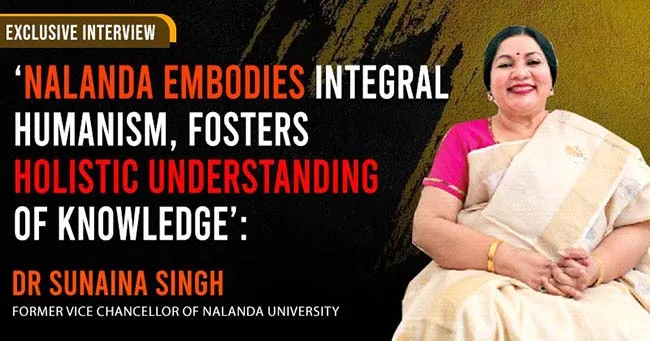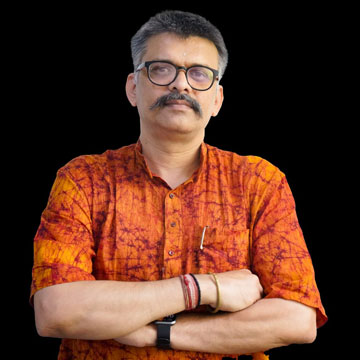When Dr Sunaina Singh took over as Vice Chancellor of Nalanda University, it was a challenge to run the institution as it was bereft of an academic framework and funds were scarce. To complicate her job, fresh graduates were among the faculty. Taking these demanding tasks in her stride, Dr Singh, who has patience and perseverance, went about her work in a methodical manner. In an exclusive interview with Organiser Editor Prafulla Ketkar, the former VC of Nalanda University discloses that she wanted the university to be more than just an academic institution. It had to provide holistic education and foster global harmony, which is much needed in contemporary times. Early on, Dr Singh realised that rediscovering ancient sciences and promoting interdisciplinary studies, while fostering regional peace through education, were essential pre-requisites. Soon, the university amalgamated science, spirituality and social sciences to foster a holistic understanding of knowledge. Like the original university, it was to be a knowledge centre that was world class. Excerpts
You have had an incredible journey while rebuilding Nalanda University. Can you describe the initial state of the university when you took over?
When I arrived at Nalanda in 2017, the situation was quite dire. The university had minimal infrastructure—just three small cabins serving as classrooms. Resources were extremely limited and there were no established policies or academic frameworks. The faculty included fresh graduates who had been given excessive increments and there were no proper examination or evaluation systems in place.
This sounds like a daunting task. What motivated you to take on such a significant challenge?
The project was very personal to me. I saw the creation of the university as akin to giving birth—challenging but deeply fulfilling. My dedication stemmed from a belief in Bharat’s historical role as a global knowledge centre and a desire to revive Nalanda’s legacy. I felt it was essential to rediscover ancient sciences and promote interdisciplinary studies while fostering regional peace through education.
I wanted Nalanda to embody integral humanism, merging different fields of study to foster a holistic understanding of knowledge. Enhancing the university’s research capabilities was also a priority
Can you tell us about the support you received from the Union Government during this process?
The support from the Indian Government, particularly from the Ministry of External Affairs and former Minister Sushma Swaraj, was crucial. This backing helped us overcome initial challenges and drive the project forward. It provided the necessary impetus to transform the vision of Nalanda into reality.
What were the primary objectives of Nalanda University?
The objectives were multifaceted. We aimed to rediscover ancient sciences and promote interdisciplinary studies. Moreover, we wanted Nalanda to be more than just an academic institution. It was to be a centre for creating knowledge and fostering global harmony. The university’s mission was to embody integral humanism, merging science, spirituality, and social sciences to foster a holistic understanding of knowledge.
You mentioned facing logistical challenges in developing the new campus. Could you elaborate on that?
Developing the new campus involved significant logistical challenges, including land acquisition and ensuring quality construction. I was deeply involved in every step, from laying the foundation to overseeing the building process. One of my key advocacies was improving connectivity to Nalanda. Establishing an airport was essential to facilitate travel and make the university accessible to students and scholars from around the world.
It sounds like you faced numerous hurdles. What kept you going through those tough times?
It was a combination of passion and the belief in the importance of the project. Despite living in a small hotel room for five months and facing skepticism from many, I persisted. The emotional fulfillment of seeing the university come to life and the support from the Government and my team kept me motivated. It was about creating something that would honor India’s rich educational heritage and contribute to global knowledge and peace.
Can you share some specific steps you took to establish a solid academic framework at Nalanda?
One of the first steps was forming a committee to develop statutes and ordinances. This was crucial to ensure the university had a robust foundation for its operations. We focused on building a framework that encouraged interdisciplinary studies and supported innovative research. Introducing a unique PhD programme that allowed for both internal and external research opportunities was part of this initiative.
What was the vision you had for Nalanda’s future?
My vision extended beyond traditional academic goals. I wanted Nalanda to embody integral humanism, merging different fields of study to foster a holistic understanding of knowledge. Enhancing the university’s research capabilities was also a priority. I believed that Nalanda should not only honour India’s rich educational heritage but also become a beacon of learning and a symbol of India’s commitment to education and cultural exchange.
The inauguration of the new campus must have been a significant milestone. How did that moment feel for you?
The successful inauguration of the new campus in 2022 was a moment of immense pride. It felt like the culmination of years of hard work and dedication. Seeing the university come to life and knowing that it would contribute to global knowledge and peace was incredibly fulfilling. It was a testament to the collective effort of everyone involved and a significant step in reviving Nalanda’s legacy.
Looking back, what do you think is the most significant impact of your work on Nalanda University?
I believe the most significant impact is reviving an institution that stands as a testament to Bharat’s historical and ongoing role as a global knowledge hub. Nalanda’s revival honours our rich educational heritage and contributes to fostering regional peace and global harmony through education. It has the potential to inspire future generations and promote a deeper understanding of the interconnectedness of different fields of knowledge. n




















Comments